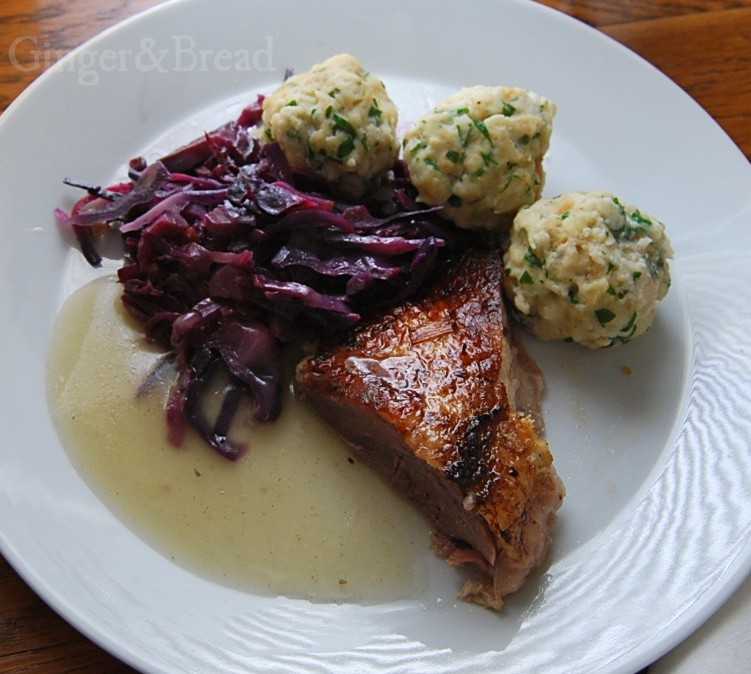• 1 goose, ca. 10lb • 4 baking apples, de-cored and cut into eighths • ½ bunch of fresh parsley, flat-leaved or curly, chopped • 2 tsp dried majoran • 1 onion, coarsly chopped • 2 carrots, peeled and coarsely chopped • ½ celeriac, peeled and coarsely chopped • 1 leek, washed and coarsely chopped • ½ tsp nutmeg, freshly ground • salt and pepper

INSTRUCTIONS
1. Preparing the goose depends very much on your butcher: if you buy it frozen, it takes around 36 hours to defrost, either in the fridge or in another cool place. Leave it in the packaging so it doesn’t dry out. Remove the goose from the fridge around half an hour before you’re going to cook it to allow it to get to room temperature.
2. Start by removing the giblets from the cavity and set aside. They come in a little bag.
3. If your goose still has a neck, you’ll need to cut it off as close to the trunk as possible; most geese have this already done to them. All you’re usually left with is fat removal.
4. Your first operation is to remove the layers of fat from the inside of the goose: they come off just by pulling them. Cut off the tail (which is incidentally called the ‘Pope’s nose’ in English): right above it is a little bubble, like a pimple, which contains fat. Loads of it. You need to cut off that whole bit without cutting into that fat gland.
5. Once you’ve cut off the tail, you cut off the end half of the wings, too, for good measure. Heat your oven to 180 C.
6. Now the stuffing begins. Wash the bird with cold water, inside and outside, and rub a generous amount of salt into both the inside and outside. Fill the bird with the apples, ½ the parsley. ½ the majoran, nutmeg and some pepper and close the cavity, using toothpicks and string.
7. Place the bird with the chest down into an oven tray and fill this with ½ inch of cold water. Place it in the oven for around 2 hours, occasionally pouring some of the liquid over the goose.
8. Now you’re left with the giblets, the tips of the wings and the neck. You can either dump them straightaway, in their little plastic bag, feeling really disgusted etc., or quickly rinse them, throw them into a small pan, cover them with water and bring it all to boil. They’ll make an excellent base for your gravy as well as adding flavour to your goose fat. And the good thing is: you don’t even have to touch or look at them ever again!
9. Once the water is boiling, add ⅓ of the remaining vegetables and onion, as well as some salt and pepper, and let it simmer for an hour or so. After two hours, you might want to start removing some of the excess fat your goose has been sweating out. Pour it into a heat-resistant jug, then add the remaining vegetables into the tray and bake your bird for another hour or so.
10. In the meantime, you can start extracting the fat: sieve the juices from the roasting tray as well as the liquid from the boiled giblets into empty jam jars, to demonstrate how much fat will separate from the juices if you let them stand for around 5 minutes; the juices from the tray can be almost 50:50!
11. You don’t need jam jars, any heat-resistant jug etc. will do. Spoon off the fat into clean lidded containers. The fat will harden overnight and turn white. Keep the remaining juices for your gravy.
12. When the hour is up it is time to turn the bird on its back; put it back in the oven for another hour but remove excess fat from the tray and separate it as above. Keep basting the goose regularly with the juices. If the skin is not brown enough, raise the temperature to 200C for the last half hour.
13. When the time is up, check the goose if it is done: cut into a fleshy part and check if the meat is cooked through. Then lift the bird onto your serving platter and cover it with baking foil to keep it warm.
14. For the gravy, mix 1tbs butter with 1 tbs flour until you get a small ball. Bring to boil ca. 250ml of your de-fatted liquid; when it boils, add the flour-and-butter ball and keep stirring until it dissolves. Once the gravy thickens, remove it from the heat.
15. Season with salt and pepper and serve. Serve it with mashed potatoes and steamed apple, or with the red cabbage and dumplings that you would have at many German families.
